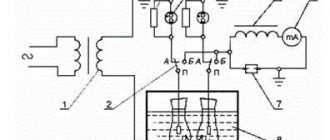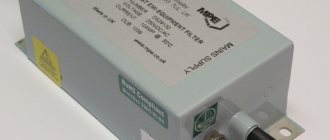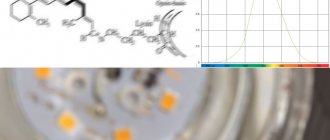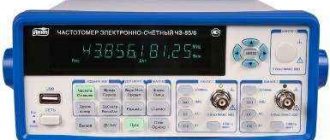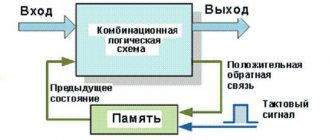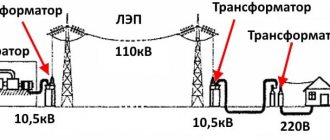Dielectric gloves, mittens, and leggings protect against current and must meet GOST standards. Dimensions (length, width), thickness are regulated by regulations. Strength, ability to isolate from electricity, withstand breakdowns and other characteristics are subject to periodic testing. The varieties are determined by the material (rubber, latex, rubber), the presence of seams, fingers, lining, and cuff parameters. Special leather and canvas gloves (linings) can be used together with electrically insulating gloves to protect them; there are also liners for insulation.
What are dielectric or electrical insulating gloves?
By dielectric (electrical insulating glove) we mean gloves made of polymers, rubbers, composites, provided for by electrical safety standards for personal protection for hands to protect against electric shock.
Appearance of a dielectric glove: rubber translucent or opaque, composite with long wide sleeves extending approximately half or more of the hand or less often with shorter cuffs. The names “gaiters” are also used, since this is the most commonly used size.
Dielectric gloves are sized to accommodate other clothing underneath. The thickness of the rubber is significant, since the current has a penetrating ability, and it also prevents the glove from shrinking, folding, creating folds, and gives them elasticity.
Additional electrical protective equipment
Let's move on to consider auxiliary protective equipment in electrical installations, which, like the main ones, are usually divided by voltage class
Please note that with the main means of protection in electrical installations up to 1000V, it is allowed to use only one additional means of protection, if this does not contradict production factors or technical requirements
Up to 1000 V
Isolating devices of this group include:
- Safety shoes in the form of dielectric galoshes or rubber boots. With the help of such products it is possible to avoid exposure to electric currents connected to the ground. It is recommended to use if the floor in the work area has a conductive coating.
- Insulating stands and dielectric carpets. The purpose of this PPE is the same as that of safety shoes. The use of carpets and stands is allowed in closed spaces (except for damp rooms) and in open spaces (in dry weather).
- A variety of insulating linings and caps. They physically prevent accidental switching on of the line on which technical work is being carried out.
Above 1000 V
High voltage auxiliaries include:
- Safety shoes and gloves with appropriate dielectric characteristics.
- Safety helmets, specialized suits, etc.
- Portable grounding and fencing of live parts.
It is typical that when working in high-voltage installations with basic protective equipment, several types of auxiliary personal protective equipment are used.
When dielectric mittens and leggings are used
The purpose and objectives of electrically insulating gloves are given by state standard 12.4.307 - protection against current (primarily industrial parameters) with voltage:
- up to 1 kV - the main means;
- over 1 kV - auxiliary.
Dielectric gloves are used when working with electrical installations (EP), typical examples:
- maintenance of pantographs from 800 V;
- replacement of high voltage safety units, lighting devices;
- manipulations with special fishing rods, rods when servicing power plants, with electrical insulating clamps, voltage indicators;
- interaction with the Verkhovna Rada;
- disconnecting terminals;
- hand protection (usually wearing gaiters) when using a fire extinguisher during fires at power plants.
GOST states that full protection is possible only for qualified specialists with experience in electrical equipment, familiar with the methods, and who have undergone instructions, including on the operation of this dielectric hermetic gloves.
Leather or canvas gauntlets are used together with dielectric gauntlets where mechanical influences and risk of damage are possible. But if the latter are composite, then you are allowed to limit yourself to only them.
General rules for testing protective equipment
1.5. General rules for testing protective equipment
1.5.1. Acceptance, periodic and type tests are carried out at the manufacturer according to the standards given in Appendices 4 and 5, and the methods set out in the relevant standards or technical specifications.
1.5.2. In operation, protective equipment is subjected to regular and extraordinary operational tests (after a fall, repair, replacement of any parts, if there are signs of malfunction). The standards for operational tests and the timing of their implementation are given in Appendices 6 and 7.
1.5.3. Tests are carried out according to approved methods (instructions).
Mechanical tests are carried out before electrical tests.
1.5.4. All testing of protective equipment must be carried out by specially trained and certified personnel.
1.5.5. Before testing, each protective equipment must be carefully inspected to check the presence of manufacturer's markings, numbers, completeness, absence of mechanical damage, and the condition of insulating surfaces (for insulating protective equipment). If the protective equipment does not comply with the requirements of this Instruction, tests are not carried out until the identified deficiencies are eliminated.
1.5.6. Electrical tests should be carried out using alternating current at power frequency, usually at a temperature of plus (25 +/- 15) °C.
Electrical tests of insulating rods, voltage indicators, voltage indicators for checking phase coincidence, insulating and electrical clamps should begin with checking the dielectric strength of the insulation.
The rate of voltage rise to 1/3 of the test voltage can be arbitrary (a voltage equal to the specified voltage can be applied by a push); further increase in voltage should be smooth and fast, but allowing the readings of the measuring device to be read at a voltage of more than 3/4 of the test voltage. After reaching the rated value and holding at this value for a rated time, the voltage must be smoothly and quickly reduced to zero or to a value not exceeding 1/3 of the test voltage, after which the voltage is turned off.
1.5.7. The test voltage is applied to the insulating part of the protective equipment. In the absence of an appropriate voltage source for testing entire insulating rods, insulating parts of voltage indicators and voltage indicators for checking phase coincidence, etc. It is allowed to test them in parts. In this case, the insulating part is divided into sections to which a part of the normalized full test voltage is applied, proportional to the length of the section and increased by 20%.
1.5.8. Basic insulating electrical protective equipment intended for electrical installations with voltages above 1 to 35 kV inclusive are tested with a voltage equal to 3 times the linear voltage, but not lower than 40 kV, and those intended for electrical installations with voltages of 110 kV and above - equal to 3 times the phase voltage.
Additional insulating electrical protective equipment is tested by voltage according to the standards specified in Appendices 5 and 7.
1.5.9. The duration of application of the full test voltage is usually 1 min. for insulating protective equipment up to 1000 V and for insulation made of elastic materials and porcelain and 5 min. — for insulation from layered dielectrics.
For specific protective equipment and working parts, the duration of application of the test voltage is given in Appendices 5 and 7.
1.5.10. Currents flowing through the insulation of products are standardized for electrical protective equipment made of rubber and elastic polymer materials and insulating devices for live work. Operating currents flowing through voltage indicators up to 1000 V are also standardized.
Current values are given in Appendices 5 and 7.
1.5.11. Breakdown, flashover, and surface discharges are determined by turning off the testing facility during testing, by readings from measuring instruments, and visually.
1.5.12. Electrical protective equipment made of solid materials should be checked by touch immediately after testing for the absence of local heating due to dielectric losses.
1.5.13. If a breakdown, flashover or surface discharge occurs, the current through the product increases above the rated value, or local heating occurs, the protective equipment is rejected.
1.4. Accounting for protective equipment and monitoring their condition 1.4. Accounting for protective equipment and monitoring their condition
2. ELECTRICAL PROTECTIVE EQUIPMENT2. ELECTRICAL PROTECTIVE EQUIPMENT >>>
Regulatory requirements for electrical insulating gloves
Dielectric gloves are regulated by the following acts:
- GOST standards:
- 12.4.103 - general concepts about hand protective equipment (hereinafter referred to as GOST, since the references are mainly to it);
- 12.4.307 - the main document, also applies to units with integrated mechanical reinforcement;
- EN 388 - protective models against mechanical influences for electrical insulating products;
- 12.4.183 - general concepts about materials and means;
- 12580, ISO 23529 - rubber, latex;
- THAT:
- 38.106977, 38.406456 - latex, En;
- SO 153-34.03.603-2003 - instructions for use.
Types, components and concepts
Types of dielectric gloves:
- bell cuff. With a bell segment. This size makes it easier to put on if you have thick clothes on your hands;
- composite (composite) - reinforced for resistance to mechanical influences;
- contour (contour) - in fact, it is a gaiter immediately (without transition), which simplifies bending;
- lined - with an internal textile layer attached to the elastomer;
- with increased length (long) - elongated, protecting up to and above the elbow (but not necessarily to the armpits, that is, the length may not take into account this segment of the body);
- mitten, also known as a mitten. Covers the entire hand, fingerless, but with a compartment for the thumb;
- without (casting) and with a seam (drilled, made by joining two sheets of rubber).
Sad statistics
According to statistics, up to 30,000 people die from electric shock every year. Most often, the causes of electrical injuries are ignorance of the mechanism of physiological effects of electric current on the human body, violation of current rules and instructions on occupational safety and non-use of personal protective equipment.
The consequences of possible injury from direct electric current can be different - from quite mild to very sad, for example:
- convulsive muscle contraction without loss of consciousness;
- convulsive muscle contraction with loss of consciousness, but with preserved breathing and heart function;
- loss of consciousness and disturbances in cardiac activity or breathing (or both);
- clinical death, that is, lack of breathing and blood circulation.
The following components influence the outcome of an electric shock:
- the duration of passage of electric current through the human body;
- frequency and type of current;
- physiological characteristics of a person;
- resistance to stress;
- voltage value.
Every employer must make every effort to eliminate the causes of electrical injuries at the enterprise. First of all, this is facilitated by the training of personnel servicing electrical installations and the use of the necessary PPE. By the way, the employer must provide personal protective equipment to employees completely free of charge when working in electrical installations.
Classification
Classification is carried out according to resistance to different substances (categories, special properties), voltage values (classes). According to table. 1 state standard 12.4.307 has the following categories:
By importance as means of protection:
- basic (up to 1 kV), marking En;
- additional (from 1 kV), Ev.
We illustrate the classes by voltage values:
Barbells
Purpose – operations with electrical equipment (arresters, disconnectors, fuses, etc.), freeing victims from electric current.
General view of the rod for working with electrical equipment
Requirements for devices are presented in current state standards.
The products consist of three parts: a handle, an insulating part and a working part. It is possible to assemble several copies to lengthen the overall structure.
Operating rods are made with detachable heads (to perform several types of operations).
No mechanical check required. Rods are subjected to increased stress on individual parts (heads, insulating elements). Voltage is applied between the insulated and working parts.
Operating rules:
- before commissioning, the threaded connection of individual parts of the rod is checked by screwing and unscrewing;
- The rods are not specifically grounded. Grounding is carried out in certain cases, when required by the operating instructions;
- horizontal and vertical movements of workers with barbells in their hands are prohibited;
- When working on objects above 1 kV, it is necessary to use dielectric gloves.
Construction and materials
The main material of the gaiter is elastomer (highly elastic elastic polymers, substances of natural or piece origin), this is sheet rubber, latex, rubber (usually piece), a composite can be added. The product may have a lining, many layers. Various compositions are used to increase chemical resistance. If there is a coating, it is of a different color. The corolla may be missing. Often, hermetic gloves are produced in a two-layer design.
Parts:
- gauntlet - from the wrist to the open area;
- cuff (cuff) - open segment;
- cuff roll - the outermost part of the cuff with reinforcement;
- fork - the place between 2 fingers next to each other;
- palm (palm) - the central part of the hand;
- wrist (wrist) - behind the cuff, the narrowest area.
Types of electrician gloves
Work with the equipment only with insulated tools after checking according to the rules (the dimensions are checked by the laboratory, markings are applied, and they are tested there). You should turn off all wires from the sockets.
When performing repairs, do not touch metal surfaces with your body and, if possible, stand on a dielectric mat. Do not perform electrical work while intoxicated, as at this time the resistance of the skin is reduced to a minimum and there is a high risk of electric shock. The most important attribute of an electrician is special equipment that allows you to reduce the risk of electric shock to an absolute minimum. This type of clothing includes dielectric gloves, boots, galoshes, etc. The most important thing in the work of an electrician is gloves - this is the main means of insulating an electrician to protect his hands from contact with electric current. They are intended for use at significantly low temperatures: from +50 o C to -40 o C, with relative humidity from 85 to 95%.
By type, gloves are divided into:
- Two-fingered;
- Five-fingered;
- Seamless;
- With seam.
They are also divided into 2 subcategories - for electrical installations up to 1000 V (these models are prohibited from being used when working with voltages above 1000 V) and more than 1000 V, where they are used as an additional protective device. Often, at low temperatures in rooms where electrical work is carried out, ordinary knitted gloves are worn under rubber gloves.
Length and thickness
There are configurations with wide and regular cuffs, contour cuffs and with a transition to a gaiter, and so on. What length by class is determined by GOST.
The position of what the length of dielectric gloves should be is in the table. 2 GOST standards, the minimum is 35 cm. The dimensions take into account the possibility of lifting elements of clothing in cold climates, pulling work clothes over the sleeves (because of this, leggings are more common).
For contour models (with cuffs of this type), there is a difference in length between max. and min. standard sizes - 50±6 mm, for particularly long specimens - 100±12 mm. Palm circumference (in mm, size N in brackets): 178 (7), 191 (7.5), 203 (8), 216 (8.5), 229 (9), 241 (9.5), 254 (10), 257 (10.5), 279 (11), 291 (11.5), 305 (12). Tolerance (allowed deviations) ±13 mm. Upon individual order, other sizes can be installed; in any case, all products are certified.
The minimum thickness is determined based on the results of testing for electrical insulation qualities. The maximum value of the smooth section (but not the corrugated segment) must correspond to the table. 3 GOST.
The thickness is also determined by the need for bending, that is, this parameter must allow for a certain flexibility and elasticity. Extended models, as well as cat. A, H, Z and R may have a different value, but not lower than 0.6 mm.
HOSE GAS MASKS TYPE PSh-1 and PSh-2
4.2. A hose gas mask completely isolates the human respiratory system from the surrounding atmosphere from any gas, steam, smoke.
4.3. Hose gas masks come in self-priming type PSh-1 and with forced air supply PSh-2.
4.4. Hose gas mask PSh-1 has the following components:
- A mask with two corrugated tubes connected in series.
10 m long hose for suctioning clean air.
Belt for attaching a hose and attaching a rescue rope.
A pin with which one end of the hose is secured in the clean air zone.
Filter box for cleaning inhaled air from dust.
A suitcase for storing and carrying gas mask parts.
4.6. Hose gas mask type PSh-2 includes the following elements:
- Electric motor for rotating the blower.
Blower with two fittings for supplying air to hoses with manual or electric drive.
Two hoses up to 20 m each, through which air is supplied under the masks.
Two masks with elongated corrugated tubes connecting the masks to the hoses.
Box in which the electric motor and blower are installed.
4.8. When performing work in oil tanks, wells, cisterns and other confined places, each worker must be served by two people. One provides the air supply, the other holds the signal rope and assists the worker if necessary.
4.9. Over the overalls, the worker must wear a safety belt, to the straps of which a signal-rescue rope is attached. The end of the signal rope brought out must have a length of at least 5 meters.
4.10. The rescue rope and rescue belt must be tested for strength, as they serve as a means of communication between the person working in a gas mask and his assistant, as well as for removing the worker from the area in the event of an accident. A hose can also be used for rescue. All its connections are made strong, capable of withstanding the load when a person is pulled out.
4.11. If there is no conditional response from the worker to the signals of the observers, they must immediately remove him from the zone.
4.12. Preparation for entering the gas-contaminated area must necessarily take place with the participation of the work manager (foreman, site manager) and consist of the following:
- A thorough inspection of the hose, corrugated tube and mask.
To check the strength and reliability of the connection of all parts of the gas mask.
Blowing out dust from the hose. Blowing is done with compressed air or several outlets from the end to which the corrugated tube is screwed. Before purging, the filter box is turned off.
4.14. When using a PSh gas mask, a worker can enter a gas-contaminated area to carry out work only after he has made sure that fresh air is supplied under the mask in an amount sufficient for normal breathing.
4.15. The duration of continuous work in a hose gas mask should not exceed 30 minutes. followed by rest in clean air for at least 15 minutes.
16. After finishing work, all parts of the gas mask are cleaned of dirt and dust and placed in a suitcase until next use.
4.17. The person responsible for the good condition of gas masks must check the serviceability of gas masks at least once every three months and note the result of the check in the “Hose Gas Masks Test Log.”
Logbook for testing and inspection of hose gas masks PSH-1. PSh-2
| date | Result of checking | Signature |
Note: When checking, pay special attention to the working condition of the mask, hose, rescue belt and rope and forced air supply device
What shortcomings should be absent?
Inside and outside, any damage, defects revealed during tests, inspections - holes, bubbles, conductive non-rubber inclusions, folds, pinches, bulges created during use - are not allowed, except for the exceptions below.
Features due to the very shape of the model or production are acceptable, for example, marks left during formation similar to a cut, but in reality this is how the edge is positioned. The following are also considered within normal limits:
- depressions, convex segments, areas extruded by shapes - if they disappear when stretched;
- inclusions - if they remain in the same place when bending or stretching;
- inclusions of paint - up to 1 mm from the inside on the working segment.
The working surface is the space between the fingers and the fingers themselves, the palm. The surface of the last two segments can be made in such a way (thickening, corrugation, etc.) to enhance the holding qualities; this is not a flaw.
Latest documents in the Database
Occupational Safety and Health
Order on exemption from on-the-job training
On-the-job training program for storekeeper
Order on the employee’s permission to work
Order on internship for a newly hired employee
Fire safety
Order on the creation of a fire-technical commission
Work plan of the fire-technical commission
Fire protection systems maintenance schedule plan
Fire evacuation plan text part
electrical safety
Order on the creation of a commission on electrical safety
Order for assignment of 1st electrical safety clearance group
Order on the appointment of a person responsible for electrical equipment
Training program group 3 on electrical safety
What must be endured
A certificate of compliance with GOST is mandatory and must be provided by the supplier. The document means that the product has been tested and can withstand the electrical, mechanical, climatic and other influence categories corresponding to its class.
After use in cold conditions in the ranges corresponding to those in which the tests were carried out, there should be no cracks, holes, etc.
Additional requirements for composite products:
Features of selection and use
Safety and ease of use are the main criteria for choosing dielectric gloves. Manufacturers also take into account other consumer requests and produce various sizes of these products.
The length according to GOST is 350 mm, and this is a characteristic feature of certified products. Dielectric gloves must fit on your hands so that you can put another warm gloves inside. Under special working conditions, special leather gloves can be worn on top to increase strength.
High-quality mittens are equipped with a technical passport, which indicates all the physical parameters of the products and the required conditions for normal operation. You need to choose gloves based on the recommended protection class of products and the nature of work on electrical equipment. Such gloves are widely used in various enterprises and public utility organizations.
Before use, gloves are checked visually each time for possible surface damage. You can also knead them using a little force to reveal any imperfections or cracks. To determine punctures, you can twist the products from the bell to the fingers.
The tightness can be checked in a simple way: fill with air, then compress a little. If the product is damaged, the defects will be immediately noticeable. This is necessary to prevent the passage of current through holes and punctures.
Products used for work are regularly washed from contamination with solutions of ordinary soap or baking soda. They need to be dried indoors, but not on a radiator.
For dielectric latex gloves, conductivity tests are required strictly according to the schedule established in the instructions. To test the product, place it, fingers down, in a metal container filled with water at room temperature. A deviation of 100 in one direction or another is possible. Water must also be poured into the gloves, and the upper edge of the bells is left dry at least 5 cm from the edge.
An electrode must be placed in the glove and a voltage of 6 kV is applied to it. It is allowed to test several pairs of gloves at the same time, the main thing is that the electric current values are monitored. If a breakdown of the product by electric current occurs, then the glove must be disposed of. In other cases, the values of the passing current are measured, and it should not exceed the norm of 6 mA.
You can find out how to test dielectric gloves before use below.
Marking
Marking is mandatory and is applied directly to the gaiter itself or to a sticker resistant to aggressive environments. The designation contains:
- name and symbol “work under voltage” - 2 triangles in the shape of a herringbone; Composite options, in addition to it, are complemented by a hammer sign;
- data on the document according to which the products were manufactured (for example, technical specifications number);
- information about the manufacturer, his mark;
- protective qualities, resistance class (category);
- size;
- the full date of manufacture, which also displays the first test. An expiration date is often not specified, only test dates are indicated, and the glove is considered to be good until the next such event;
- reference to the act to which the product complies;
- sign for market circulation;
- classes;
- category;
- care, disposal standards;
- other information on the manufacturer’s TD and/or agreed with the consumer.
Some of the information on the label is displayed by signs.
Place of marking: cuff, no closer than 2.5 mm from its edge; for extended versions, this gap is from 30 cm, since it is possible to cut off a part to suit individual requests.
Correspondence table if color code is used in marking:
In addition to the factory markings, inspection stamps are placed:
Marks on the passage of regular mandatory checks and the dates of the next events can be placed directly on the glove; these designations, as well as any other markings placed after the manufacture of the product, should not cover the original (main) inscription.
INSPECTION AND TESTING OF BELTS, CARABINES, ROPES OF GAS MASKS TYPE PSH-1, PSH-2
2. Testing of life belts is not allowed if the following defects are present:
2.1. Damage (tear or cut of any size) to the waistband or shoulder straps.
2.2. Damage to the fastening straps.
2.3. Buckle malfunction.
2.4. No washers on the rivets.
2.5. Rivet slot for the waist band of straps or belts.
2.6. The presence of looseness or protrusions in the place where the valves are hinged.
2.7. Weak carbine bolt springs.
3. Rescue belts, carabiners and ropes are subjected to periodic strength testing with a statistical load of 200 kg twice a year.
4. When testing a rescue belt, a load is attached to the ring of this belt, fastened with buckles and suspended on both straps, under which the belt remains for 5 minutes. The test is considered successful if, after removing the load, there is no damage to the belt.
5. A carbine suspended by the eye with the bolt open is tested under the same load for 5 minutes. The carbine is considered to have passed the test if, after removing the load, its shape and dimensions do not change, and if the released carbine bolt freely returns to its place.
6. The rescue rope is tested by suspending a 200 kg test load for 15 minutes. The residual elongation of the rope, determined by measuring its length before and after the test, should not exceed 5° of the original length.
After testing, the rope is inspected and there should be no damage to it.
7. The test results of the rescue belt and rope are recorded in a special journal or documented in a report, and a tag indicating the belt number, static load and the date of the next test is attached to the belt and rope.
What to pay attention to
Each pair is individually packaged, hermetically sealed, with sufficiently durable material for storage. On the outside of the package, the factory data, model features, class, cat., size are written down. Inside there are instructions with the following minimum information: how to store, use, dispose of, periodically inspect and test, GOST.
Functional applications of protective gloves
Dielectric gloves are produced in two versions; the choice of a pair of gloves will be determined by the specific purpose of the application:
GOST 12.4. 103−83; deciphering the markings as “low” and “high”, respectively
Tests, service life
Requirements, frequency of tests, verification period for dielectric gloves, methods for analyzing the condition are in GOST 12.4.307. Basic and thorough tests are carried out at the factory before delivery, as well as periodically by responsible persons during storage and operation at enterprises. In addition, before each donning, the user must check dielectric gloves, including inspection and twisting to the fingers.
The standard service life of dielectric gloves is 1 year, subject to testing every 6 months. The manufacturer has the right to set other periods, and this is allowed, since the products are certified, that is, the time frame is consistent with regulations. The warranty period is indicated on the manufacturer's stamp or in the product specification document; it usually meets the rules described above.
Test frequency
The product cannot be used if it:
- has not been tested within the last 12 months;
- was not tested within 6 months. after commissioning.
The date of manufacture refers to the day on which the initial testing was performed.
The composition of periodic tests: inspection, air testing, for physical and mechanical qualities, dielectric properties, low temperatures, punctures, aging, fire resistance, for the influence of category-determining factors (oil, acids, etc.). The manufacturer has the right to recommend methods and methods if there are any special features. After the tests, the gloves are stamped (but in such a way as not to cover the very first marking) with confirmation of their passing and the date, or a mark is placed on them as defective or unsuitable.
So, the first time, if we do not take into account testing at release, is tested when a new batch arrives; this is required in order for the product to be accepted for service, for service. Select any pair; if a breakdown is observed, take two pairs, conduct tests more carefully, and if the results are negative, reject the whole batch and return it to the manufacturer. If the results are positive, a stamp is placed on each specimen indicating the testing period (after 6 months). Based on the results of the procedure, an act (protocol) is drawn up, and the data is entered into a special journal.
Inspection
The absence of moisture, imperfections, and holes is analyzed visually and by touch. They also verify the presence of markings and certificates. The inspection is done in normal light without special equipment.
Length, width, circumference
The length is measured from the tip of the 2nd finger to the edge of the cuff with a metal ruler (0–500 mm, GOST 427) with millimeter graduations. The product is straightened, the cuff is perpendicular. The length difference for models with contour cuffs is determined on a straightened product along an axis parallel to the length of the measurements. The circumference is checked with a tape measure in a place 2 cm between the fingers - thumb and index.
Thickness measurements are taken at the following points:
- 4 or more on the palm;
- 4 or more on the back, but not on the cuff;
- 1 or more on the fingers: big and adjacent.
The points should not be closely grouped in one place and on segments (grooved and similar) to enhance grip. The procedure is carried out with a micrometer with a measured value. 0.02 mm, a thrust rod of 6 mm, a clamping foot ∅ 3.17±0.25 mm, the load of which is 0.83±0.03 N. During the procedure, the mitten is straightened between the thrust rod and the clamp.
Marking durability
The stamp is wiped for 15 seconds. a rag with a soap mixture, and after 15 seconds. - with isopropanol. A sign of normality is clarity and lack of vagueness. Signs made by engraving or molding are not tested; they are checked visually and by touch.
Physical and mechanical properties
For testing, samples conditioned according to ISO 23529 are taken. To analyze the elastic-strength properties of products with a lining, samples from varieties without it are used. Testing for tensile strength, maximum elongation before damage and rupture is carried out according to state standard 12580. Samples are cut out in the shape of double-sided spatulas, 4 pieces are made: from the palm, from the back, and one from the wrist.
Puncture resistance
Puncture resistance is analyzed using methods according to EN 388. The results are positive if they comply with table. 4 GOST. For products made from composites, the force must exceed 60 N.
Dielectric properties
Insulating qualities are determined by testing using test EC. This is the most detailed test with many conditions and stages. The procedure is described in R. 5.7 of GOST, we present it briefly:
- The glove is conditioned by keeping it in water for 16 hours and drying for 0.2±0.1 hours at +70 °C. After 1 hour, testing begins.
- The mittens are filled with water so that the resistance is 100 ohms and placed in the bathroom. The distances to the edge of the container are regulated by established standards (Table 6 of GOST). The top 55 mm remains dry, above water. The fluid level inside and outside is the same. Water in the product is one electrode connected to 1 power source, outside it is the second, with another.
- The installation (transformer) supplies voltage (of all types) to the mitten, the EC must have fuses.
- The leakage current is measured with a milliammeter probe placed in the glove.
- Alternating current is supplied, slowly increasing from the lowest value by 1 kV/s until the required value is reached, after which it is held for 3 minutes.
- The tests are passed if the normalized values are reached, they are maintained according to the standard time, the current leakage is within the limits according to GOST and if there is no breakdown.
One end of the circuit is grounded. If a single glove is being tested, the liquid in the container is connected to the grounded end of the high voltage circuit, to which an ammeter is also connected. The latter is also bypassed by an auto-closing switch, which maintains the circuit closed, except for the moment of measurement - this method creates continuity of connection with the ground.
If 2 gloves are tested at the same time, the electrodes inside them are grounded, the ammeter is then connected to the ground cable through an appropriate switching circuit so that measurements can be taken on each product separately.
Table showing what voltage rubber dielectric gloves are tested:
Other tests
The following tests are also carried out:
- for aging. Placed in a thermostat for 168 hours at t° +70 and humidity up to 20%;
- resistance to low temperatures. Placed in a chamber at t° −25 for 1 hour, after the sample is removed, it is placed between two polyethylene plates and a force of 100 N is applied to it for 30 s, and testing (but already dry) for leakage current is carried out;
- flame propagation resistance. The finger is cut off, filled with alabaster, after hardening, hung up and exposed to the burner flame for 10 seconds. After it is removed, observe the spread of the flame for 55 seconds. The mitten has passed the test if the fire does not reach the border on the sample at 55 mm from the edge (from the fingertip) within 5 seconds;
- additionally they test the resistance of each category, the substances and phenomena that determine it (oil, acids, very low temperatures, and so on) according to R. 5.10 of GOST.
Test technology
The electrical protective characteristics of rubber and latex gloves should be checked every six months. Products that have passed the test period cannot be used.
Do not forget that this deadline was not assigned by chance, and do not miss timely checks. After all, over time, the dielectric properties of the mittens may decrease or disappear completely (due to intensive use or violation of storage rules). The use of poor quality PPE can result in a worker being seriously injured due to electric shock.
Tests are carried out using a metal container with water heated to 20-40°C and a test transformer. The mittens are lowered into a tank of warm water so that the liquid fills them from the outside and inside. The top of the mittens protrudes about 4-5 cm above the surface of the water; this part should remain dry.
One terminal of the transformer is connected to the tank, and the other is grounded. Electrodes are placed in the gloves and connected to ground via a milliammeter. To check the properties, an electric current is passed through the product. If sharp fluctuations occur or the current exceeds the norm, dielectric gloves are rejected. A breakdown indicates a violation of the tightness; such mittens are also prohibited from being used.
Rice. 8
Electrical insulating gloves are tested in accredited electrical laboratories in accordance with the requirements of TKP 290-2010. Information about the date of the next test of the electrical insulating properties of the product is applied to the stamp using a sticker or reprinting. A corresponding entry is also made in the test log.
Operating rules
Let's look at the rules for using dielectric gloves point by point, what standards must be adhered to in order to prevent the use of a damaged product with degraded quality. The procedure for inspection and storage is established by regulations and the manufacturer.
Storage
Before use and in the intervals between testing, gloves are kept in closed rooms, warehouses in containers, individually packaged at +10°... +35° C, humidity up to 40–60%. Requirements for the location: protected from direct sun, ultraviolet radiation, heat radiation, and compounds that have a detrimental effect (including evaporation) on polymers (petroleum, oils, turpentine, solvents, strong acids). During transportation, when there are temperature fluctuations, the batch is waited for a day before disassembling.
Temperature
Conventional dielectric gloves are used at temperatures from −25 to +55, for cat. C operating mode −40… +50. Other ranges may be specified by the manufacturer and are allowed during product certification.
Precautions
If leather gloves are worn over them, their size should be such as not to deform the dielectric underneath. When using the upper edges of the hermetic gloves, it is forbidden to wrap, bend or fold them. The minimum gap between the cuff of the first and the top of the cuff of the second is no less than that prescribed in clause A. 1 of GOST.
The absence of damage to leather (canvas) protection (holes, cracks and any others) that reduce the security of dielectric products is a mandatory requirement. It is also necessary to ensure that they are free of contamination that creates the risk of the listed disadvantages. Before use, contaminated leather products are inspected and cleaned, and the internal surface is always checked - there should be no sharp, protruding parts.
Dielectric gloves must be cleaned after use, especially if they are contaminated with petroleum products or fuels and lubricants. The procedure must be carried out promptly so that the substances do not have time to cause harm. In this case, follow the manufacturer's instructions or use compounds that do not destroy latex or rubber (wash with soda, soap solution). Wet gloves are thoroughly dried at temperatures up to +65.
Storage
Dielectric gloves should be stored in a dry, clean place in a loose condition. It is strictly forbidden to twist or fold them, as this can lead to cracking and loss of dielectric properties. In the storage room, temperature fluctuations are allowed within the range from – 30°C to +40°C, humidity levels should be in the range from 40 to 60%. You should not leave them in close proximity to heating devices, dishes with alkali or acids, containers or mechanisms with mineral oils, as the impact of these factors reduces the dielectric properties.
If dielectric gloves are rejected, they should be stored separately from suitable ones in order to exclude human error.
Check before use
Checking dielectric gloves before use includes:
- inspection;
- air check;
- checking the test date on the stamp or in the TD, passport;
- make sure it is dry;
- analyze by marking the size, class, category for the work performed.
There is a standard way to check dielectric gloves for punctures with air: by twisting them towards the fingers.
Procedure for using protective equipment
According to the current Rules, PPE, as inventory property, must be stored in premises designated for this purpose and issued to field teams or for individual use.
Only those protective equipment in electrical installations that have passed tests are allowed for use, and there is a corresponding entry on the product stamp.
As for the norms of distribution, they depend on internal regulations, which take into account the characteristic conditions in a particular organization. But at the same time, violations of the requirements of safety and labor protection standards are not allowed. When distributing, information about storage locations is required to be retained. For this purpose, special lists are provided, recorded with the signature of the responsible person and the seal of the organization.
If during the testing process or during an external inspection unsuitable personal protective equipment is identified, they are subject to write-off, followed by removal from the storage location. Information about this should be reflected in the protective equipment record book or operational documents, for example, when the unsuitability of personal protective equipment is discovered on the road.
Electrical personnel, after receiving PPE in hand, bears full responsibility for compliance with operating rules and must be able to independently determine their current condition, as far as possible under working conditions. In this case we are talking about external inspection for integrity.
Protective equipment in electrical installations intended for enclosed spaces can be used in open spaces, but only if the weather is dry. In case of frost, rain or high humidity, it is necessary to use specialized tools designed for use in such weather conditions. A note on the relevant electrical tests must be included in the product passport.
Before starting to operate PPE, electrical personnel are required to check for any punctures in the insulation or other damage. It is mandatory to check the permissible service life and the date of the last tests. This information is contained in the stamp. It is strictly prohibited to use expired protective equipment during work!
To avoid exposure to touch voltage, do not touch the working surfaces of PPE during operation, as well as insulating parts outside the limiting stop or ring.
Key points and terms
Electrical protective equipment - (items) that serve to protect people from electric shock, exposure to an electric arc or electromagnetic field when working in electrical installations.
They are divided into basic and additional.
Basic electrical protective equipment - their insulation can withstand the operating voltage of electrical installations for a long time, which allows you to touch live parts that are energized.
Additional electrical protective equipment - by itself cannot provide protection against electric shock and is used in conjunction with basic electrical protective equipment.
All electrical protection means in electrical installations must meet the requirements of state standards.
I recommend that when purchasing them, be sure to check the availability of certificates of conformity. Especially if you are buying them for your staff. Because if you are a manager and a malfunction is discovered, they will ask you.
Personnel carrying out repair work on electrical installations must be fully provided with all the necessary protection, trained in the rules of their use, and must use them to ensure the safety of the work.
Protective equipment must be present as an inventory in electrical installation rooms. Can also be issued for individual use.
You should only use electrical protective equipment that is marked, indicating the manufacturer, name or type of product and year of manufacture.
Be sure to pay attention to the test stamp! He must be present. If the test period has expired, you have the right not to start work
Remember this and always pay close attention to this. Your safety is at stake and more.
Insulating electrical protective equipment should be used only for their intended purpose and in electrical installations with a voltage no higher than that for which they are designed. This data is written in the operating manual, instructions, passport for a particular electrical protection device
Also pay attention to the weather conditions in which you are going to work.
We will not go into details about storage conditions, just a few words - protective equipment must be stored in conditions that ensure serviceability and suitability for use; they must be protected from mechanical damage, contamination and moisture.
To get an electrical safety permit, you need to know all this!
Now more about the exam, as promised.
Testing protective equipment in electrical installations, ignorance of standards and deadlines, this is not the main criterion for my failure. Everything went well, I explained what kind of protection there is in electrical installations, how to provide assistance to a victim in case of electric shock (release, artificial respiration, external cardiac massage, etc.). Internal labor protection rules. And when they asked me what work I had already done and how I checked the absence of voltage, I showed my homemade voltage indicator.
That's all I failed! Who knows, he understood. Well, for those who don’t know, it is prohibited to use homemade devices and test lamps (a socket with an incandescent lamp and two wires) to check the voltage. I assembled this index myself, under the strict guidance of a colleague who is 74 years old, an electronics engineer and knows what’s what. I still use it to this day, it works well.
=> Next exam.
Joke:
— What is step voltage? - This is the tension that arises between the legs when approaching the bare end...
